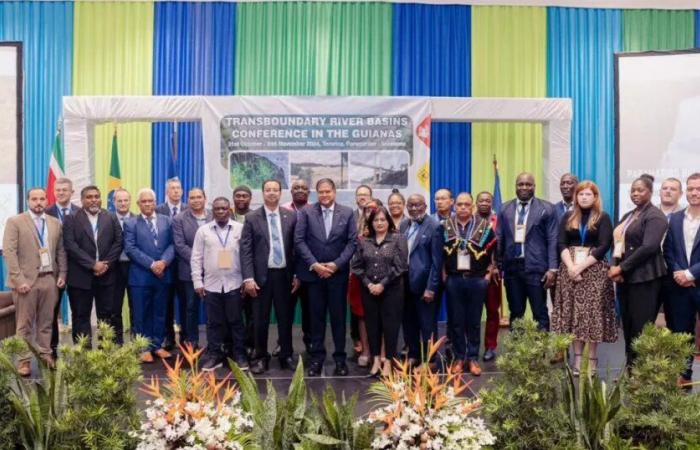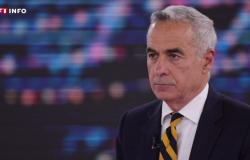
The Bio-Plateaux project, a cross-border cooperation program initiated in 2021 for the integrated management of water resources between Guyana, the State of Amapá in Brazil and Suriname, enabled a major meeting from October 31 to November 2 in Paramaribo. For three days, political and environmental actors from the three territories visited hydraulic infrastructures, such as the Brokopondo dam, and participated in conferences, debates and strategic discussions. This meeting marked progress with the creation of a regional observatory for transboundary watersheds of the Guiana Plateau, an initiative aimed at promoting the sharing of information and experiences in the areas of water and aquatic biodiversity.
A strategic tool for ecological resilience
Jean-Paul Ferreira underlined that this observatory represents a decisive step towards common management of waterways between the three countries, allowing: “It is a strengthening of the means implemented so that the joint management of aquatic environments is intelligent with several partners and above all to find solutions together on the living environments of the population with regard to the consequences of climatic hazards transposable to a country to the other”.
Riad Nurmohamed, Minister of Public Works of Suriname, welcomed the convergence of territories and Surinamese national policy, focused on climate change, water management and pollution reduction. The importance of this cross-border cooperation was also recalled by Surinamese President Santokhi, who had just returned from COP16 on biological diversity in Colombia. He insisted on solutions that could rely on proven models in the Amazon region via ACTO (Amazon Cooperation Treaty Organization).
Among the concrete actions that will be implemented in the coming weeks and months, the installation of a turbidity measurement unit, financed by Bio-plateaux, at the mouth of the Atapaoni, a tributary of the Maroni. “ Water turbidity is an important marker for monitoring gold mining. The idea is to go into the field and install the data station together and have data transmitted back to the Surinamese and Guyanese experts. », explains Luken Delinthe, local coordinator in Guyana of the BIO-PLATEAUX project for the International Office for Water.
Awareness raising and consultation with Indigenous populations
Representatives of indigenous peoples, including Sônia Jeanjacque, secretary of indigenous peoples of Amapá (SEPI), took advantage of this meeting to recall the direct impact of water pollution and climate change on their communities. Same story from the customary authorities of Guyana. “ The gold activities carried out on the Surinamese side of the mercury whereas in our country the legal activity prohibits it. They pollute the river and impact populations who live from hunting and fishing », recalls Bruno Apouyou, of the Grand Customary Council.
The Grand Customary Council of Guyana insisted on the need for the authorities to consult customary authorities before authorizing certain activities, particularly mining, on the Maroni River. However, Sylvio Van Der Pijl, the president of the Grand Customary Council recognizes that the process is complex, due to legislative differences, the economic issues of each country and their sovereignty: “There is reason to provoke discussions directly with the Surinamese authorities on their very different regulations. We will try anyway even if we know of certain obstacles.” Riad Nurmohamed, Minister of Public Works of Suriname, questioned on this subject by our editorial staff, did not appear to be reluctant to discuss it.
Water management that cannot be done without legislation or training
The meeting made it possible to address the slowness of legislative processes in terms of water management and the protection of aquatic ecosystems, as indicated by Gonda Asadang. The permanent secretary of the water supply department of the Ministry of Natural Resources of Suriname ensures that progress is being made to establish a common water management plan: “Without legislation, we cannot offer satisfactory water management. We have legislative proposals in progress and there is progress. The next regulations and the observatory will make it possible to move towards the development of a water management plan in Suriname.”
On the Brazilian side, Mirna Pinheiro Caniso, head of the conservation unit at the State Secretariat of the Environment of Amapa, highlighted the importance of training environmental agents to strengthen cooperation between the three territories: “It is important that universities train competent agents for water management and more generally for the management of Amazonian biodiversity. Universities from the three countries must carry out more joint work.”
Read also: Regional cooperation in Guyana around water management: visit to the Brokopondo dam as part of the Bio Plateaux conference
The challenge for these three territories will therefore be to reconcile economic development and preservation of biodiversity, by integrating local knowledge and raising awareness among populations of the importance of sustainable water management. Ultimately, it would involve creating a common management body for decision-making, on the modalities of actions and their financing, like what is done on Lake Titicaca or in the Danube watersheds.
Radio Country





